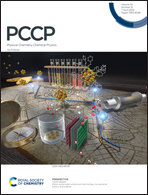Pyridine interaction with γ-CuI: synergy between molecular dynamics and molecular orbital approaches to molecule/surface interactions†
Abstract
We have used a synergistic computational approach merging Molecular Dynamics (MD) simulations with density functional theory (DFT) to investigate the mechanistic aspects of chemisorption of pyridine (Py) molecules on copper iodide. The presence of both positive and negative ions at the metal halide surface presents a chemical environment in which pyridine molecules may act as charge donors and/or acceptors. Computational results reveal that Py molecules interact with the γ-CuI(111) surface owing to a combination of noncovalent Cu⋯N, Cu/I⋯π/π*, and hydrogen bonding interactions as determined via Natural Bonding Orbitals (NBO). Introduction of surface defect sites alters the interaction dynamics, resulting in a “localizing effect” in which the Py molecules clump together within the defect site. Significant enhancement of hydrogen bonding between C–H σ* and I 6p orbitals results in more tightly surface-bound Py molecules. Our findings provide a platform for understanding the interaction between Py and Py-derivative vapors and metal-based surfaces that contain both electron acceptor and donor atoms.



 Please wait while we load your content...
Please wait while we load your content...